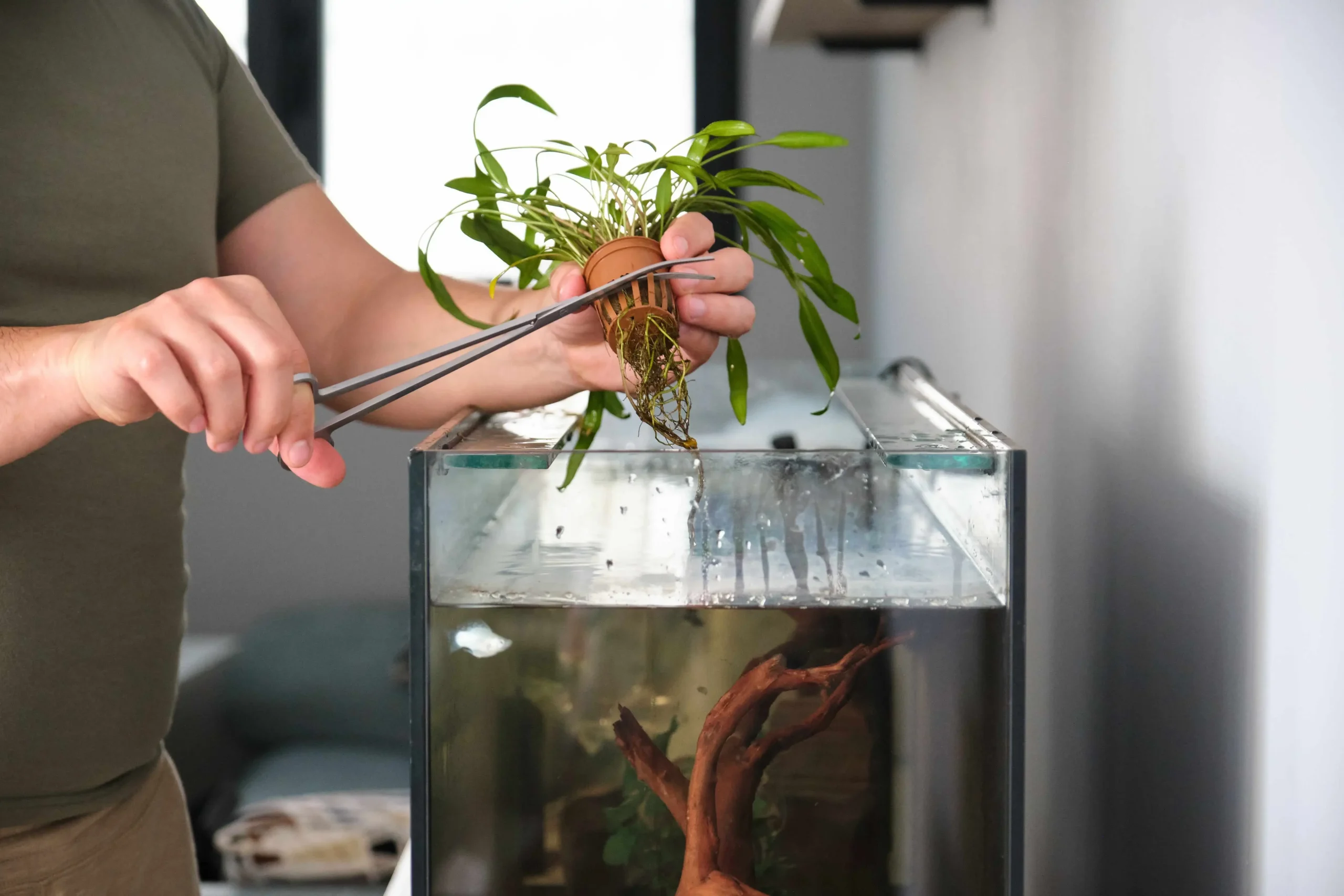Want to add live plants to your axolotl’s tank? Good call. They look good, improve water quality, reduce stress, and bring the tank to life.
But you can’t just put any plant inside because axolotl prefers cold temperatures (tropical plants don’t like that). Axolotls are not fond of bright light, which is a requirement of most plants. Also, axolotls are sensitive to chemicals and fertilizers, so you can’t use them for plants either.
So, your plant choice should be strategic. Here, I’ll cover everything: the best plants, what to avoid, and how to keep your tank thriving. Let’s start!
Table of Contents
Why Live Plants?
1. Natural Enrichment and Low Stress
In the wild, axolotls live with aquatic plants such as water lentils, horsetail, Myriophyllum, Epilobium, willows, Malvaceae, Viliaceae, and Umbelliferae.
You can also add live plants to the axolotl tank to mimic their natural environment and give them a sense of security. Plants offer shelter and hiding spots, and Lucy also loves to hide around plants.
2. Better Water Quality
Ammonia and nitrites in the axolotl tank are regulated by nitrifying bacteria. But they don’t remove the end product called “nitrates.” Plants act as a natural purifier and absorb nitrates and improving the water quality of the tank.
3. Aesthetically Pleasing
Plants increase the visual appeal of the tank and create a natural environment for the axolotl. They’re also comfortable for your axolotl.
Read More About: Axolotl Nutrition and Feeding Requirements
Top Live Plants for Axolotl Tank
Here are some axolotl-safe plants that can survive in cold water, with low light, and require minimal care. I use Pothos and Amazon Swords in my tank, but you can use others too.

1. Pothos
A lot of people warned me that pothos leaves will rot underwater. Months later, I can say confidently that mine haven’t. There is no rot, no issues.
Plus, pothos helped me keep my nitrates in check. I haven’t seen levels go over 5–10 ppm since I added it. The best part is that Lucy loves to play in the leaves and roots of it. She weaves through the roots and hides behind the leaves. Just don’t fully submerge the entire plant in the water, as its leaves need air.
Take a healthy stem cutting from the mother plant so that it has at least 2-3 nodes (a place where new roots emerge). Remove the leaves from the bottom of the stem. Place it in a small container partially filled with water and wait for a few days until you observe the roots are 3-4 inches long. Now move it to primed water for 24 hours and arrange it in the axolotl tank.
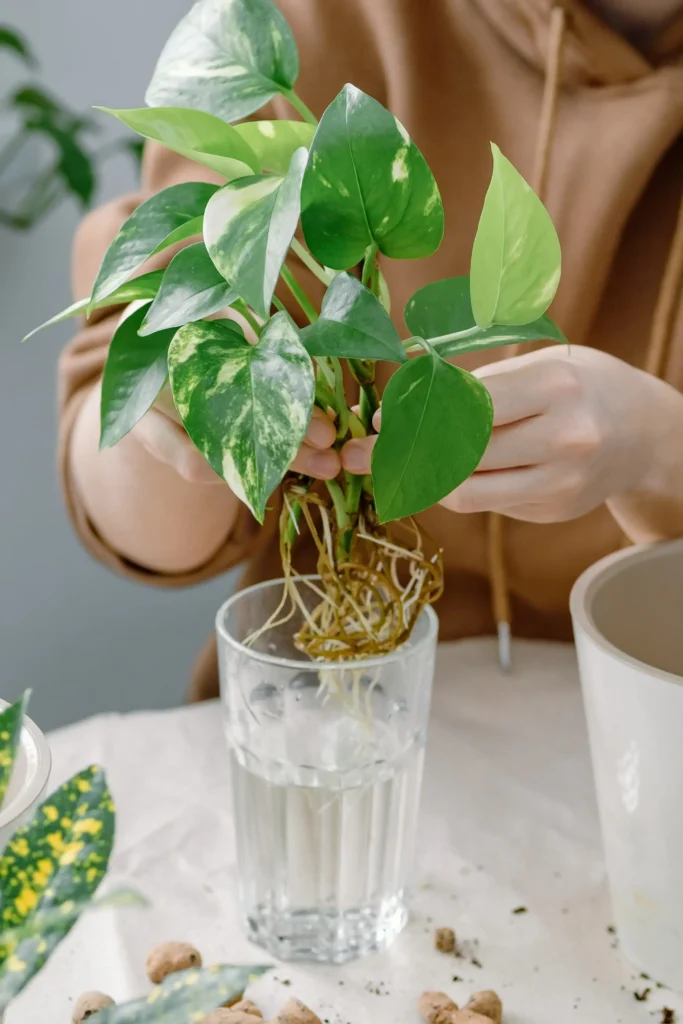
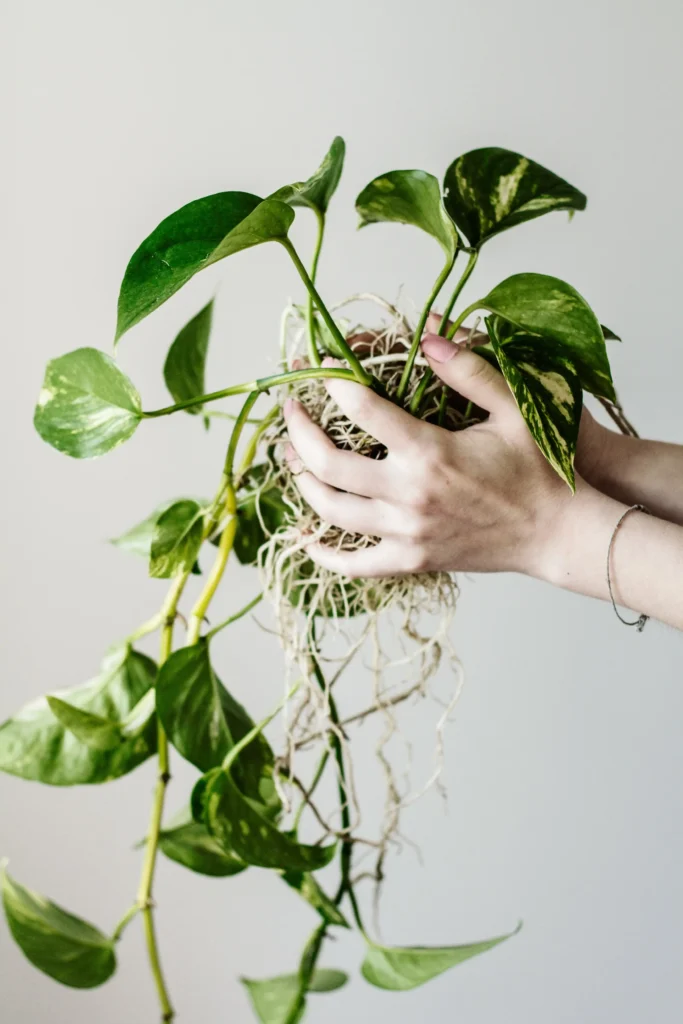
2. Amazon Swords
Amazon Swords (Echinodorus) is a vibrant green plant that adds a natural and aesthetic look to my axolotl tank. It also improves water quality and absorbs nitrates.
To use Amazon swords, you need fine sand as substrate. The roots should be merged into the soil, but the leaves and crown should be exposed. The plant should be well-anchored in the tank so that the axolotl won’t disturb it. Also, check the tank size before purchasing the plant as Amazon Sword as they can grow huge. You can also trim the leaves to get the desirable size.

3. Java Fern
Java Fern (Microsorum pteropus) care requirements are simple, and it can survive in an axolotl tank. They have tall green leaves that provide shade and a hiding place for the axolotl. It’s super easy to propagate and grow fast compared to other plants.
Java fern is a rhizome-based plant, so don’t bury it in the substrate, or it will rot. New leaves grow from the rhizome and plants turn into a bushier shape. You should use an aquarium-safe glue or twine to anchor it on rocks, driftwood, or a tank.
4. Anubias Nana
Anubias Nana is an adorable dwarf variety of the Araceae family. It also controls the nitrates levels in the water, oxygenates the water, and creates healthier conditions for axolotls.
Like Java Fern, Anubias also has rhizomes, so do not bury it in the substrate. Tie it to driftwood rocks or other decorations by using aquarium-safe glue, fishing line, or thread.
If you simply toss the plant inside the tank, Anubias can wrap its roots around the nearest object. But it takes some time to settle.
5. Hornworts
Hornworts (Anthocerotophyta) are a great floating plant for your aquarium. It helps in absorbing nitrates and water filtration. It is resistant to cold and thrives for a very long time in the axolotl tank. You can leave it to float freely or anchor it on the substrate.
Floating hornworts give a natural vibe and provide shade to your axolotl. If you want to anchor it, use driftwood or rock to weigh down the hornwort from the base. Gently bury 1 inch of the base of the plant in the substrate to secure it.
It needs some time to acclimate to the tank. The only problem with Hornworts is that they shed their needles for a few days in the beginning. Although the needles will grow back, they will create debris in the water, so you may need to vacuum the water frequently.
Otherwise, it has no detrimental effects on the water quality of the axolotl. If your plant is disintegrated into particles without any green part left, you should discard the plant.
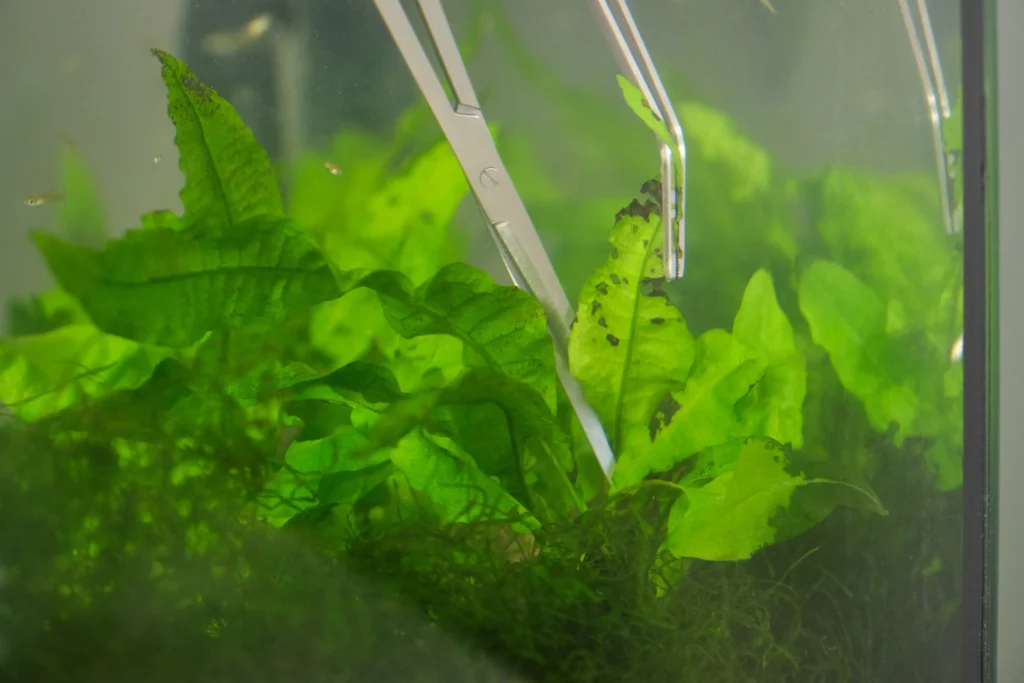
6. Elodea
Elodea (waterweed) is also great for axolotl tanks. It also absorbs excess nutrients from the water and maintains water quality. It is adaptable in almost every aquatic environment, and you can arrange it in several ways. Leave it to float or bury 2-3 inches of its bottom in a nutrient-rich substrate.
7. Vallisneria
Vallisneria (val) is a classic grass-like aquatic plant good for axolotl tanks. It spreads quickly via runners and forms lush underwater curtains. It provides excellent hiding spots and shade.
Vallisneria tolerates cooler temperatures, moderate to low lighting, and a variety of substrates. So, it’s low-maintenance and axolotl-friendly
Its leaves create a naturalistic background and help stabilize water quality by absorbing nitrates. Just keep an eye on it and trim if needed to prevent overgrowth.
Are Plants Safe for Axolotls?
Yes, plants are safe for axolotls. Axolotls do have a habit of eating everything that is around them. But most aquatic plants are safe even if they munch on some by mistake.
Avoid Duckweek as it spreads rapidly and covers the whole tank water. The same goes for Marimo balls or anything that is smaller than the axolotl head, with a risk of choking.
Plus, don’t use plants with sharp edges, as they can result in physical injury to your axolotl’s skin and gills. Under any circumstances, avoid experimenting with an unidentified wild plant.
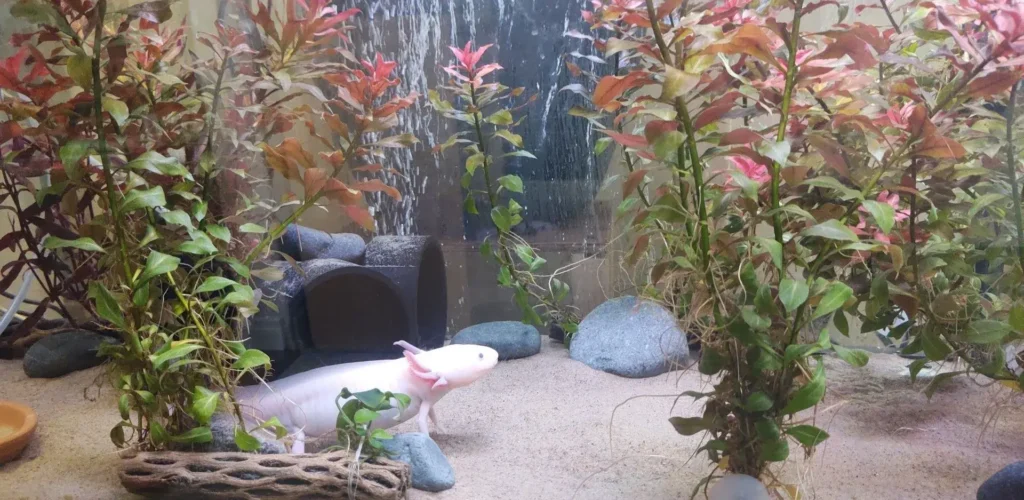
Quarantine Your New Plants
Quarantine new plants before you introduce them into your axolotl tank. It will help prevent pests, parasites, and unwanted algae from growing in the water.
Rinse the plants with old tank water or dechlorinated water and remove any damaged leaves or parts.
Inspect the plant thoroughly, and look for snails or small creatures moving around them.
Monitor the plant for 2 weeks, and if the plant shows no signs of disease, rinse it in dechlorinated water and place it in the axolotl tank.
FAQs
What is the Best Substrate for Live Plants?
Fine sand (grain size < 1 mm) is the best choice for axolotls and plants. You can also use bare bottom with pots or tiles. It’s easy to clean, though it sacrifices planting space.
How to Plant in an Axolotl Tank?
For rhizome plants like Java Fern and Anubias Nana, secure their rhizomes to driftwood or rocks using thread or aquarium glue. Don’t bury the rhizome in substrate.
Root-feeders (Amazon swords, Cryptocoryne, Vallisneria): Loosen the root ball, insert into sand substrate, and leave the crown above the sand to avoid rot.
Drop the floating plants in specific zones, and no planting is needed.
What Not to Put in an Axolotl Tank?
Coarse Gravel: Can cause impaction if swallowed. Avoid anything > 1 mm
Wild-Collected Plants: May carry pests, diseases, or toxins. Just use safe plants.
Sharp and Fertilizers: Skip jagged leaves and don’t use copper-based or unknown fertilizers, as amphibian skin absorbs chemicals easily.
What are the Best Aquarium Plants for Sand Substrate?
Hardy, cold-water tolerant species include Vallisneria, Cryptocoryne, Amazon Sword, Hornwort, and Anacharis (Elodea).
Which Floating Plants Can I Use?
Floating plants are great for shade and nitrate control. You can use Hornwort, Amazon Frogbit and Floating Indian Fern in an axolotl tank.
Do Tank Plants Need Fertilizers?
Axolotls are sensitive to chemicals due to their semi-permissible skin. They can easily absorb substances from the water. So, avoid using fertilizers in the axolotl tank. The plants I listed do not require fertilizers either.
Is Cardinal Plant Safe for Axolotls?
No, it is not safe due to the risk of toxicity if ingested. If your axolotl has a habit of nibbling, it’s better to avoid the plant.
Also Read:
The Axolotl Diaries
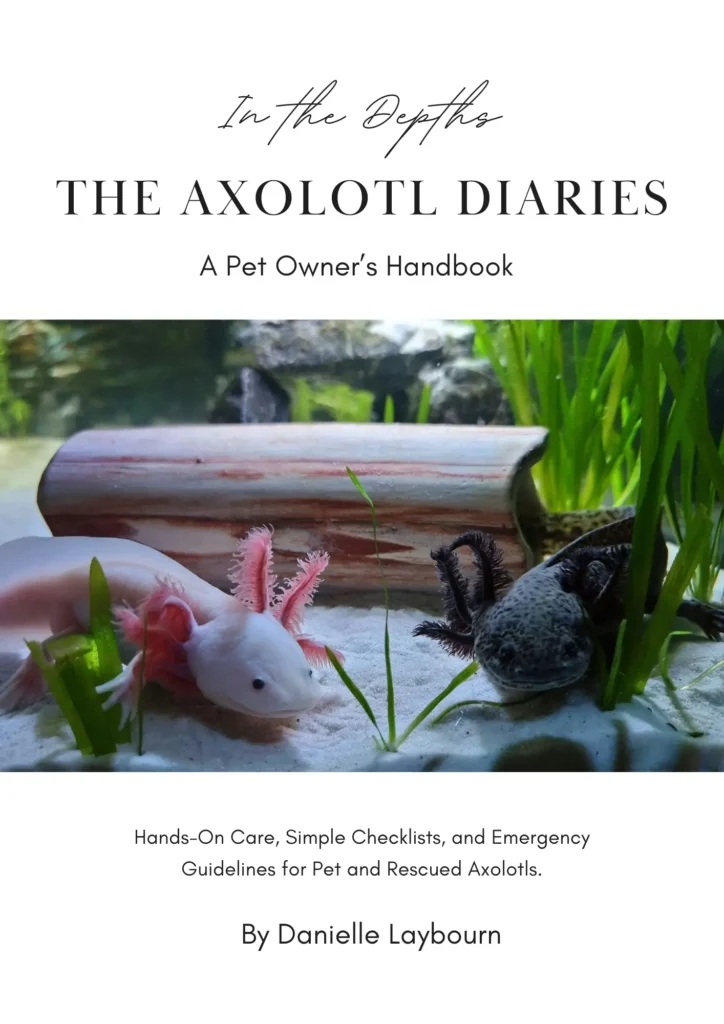
A clear, step-by-step handbook (50+ pages) about axolotl care that covers basics, safe tank requirements, cycling, feeding, common health issues, and more.
Rescue-informed and vet-aware. For anyone who wants to raise a healthy, happy axolotl.
Find everything in plain language, backed by real experience.
Grab printable cheatsheets, practical tips, and easy troubleshooting guide inside!
Price: $14.99
Wrapping Up
Live plants don’t just sit pretty, but make your tank a safe, rich, and interactive home for your axolotl. Just choose safe, hardy plants, follow the basic care tips, and enjoy the transformation.
Do you have plants in your axolotl tank? Share your setup in the comments, or tag us online!

